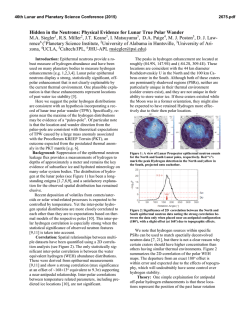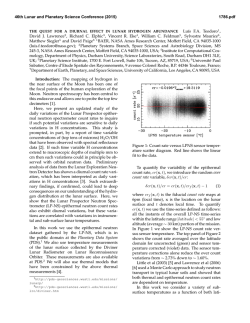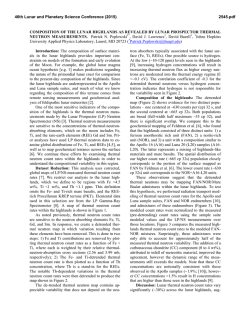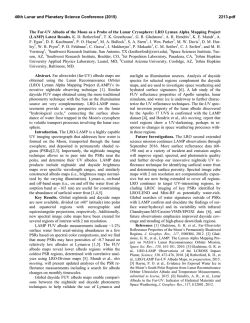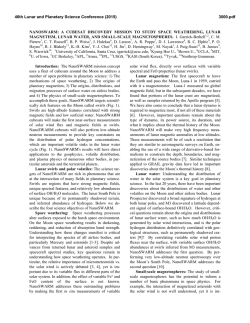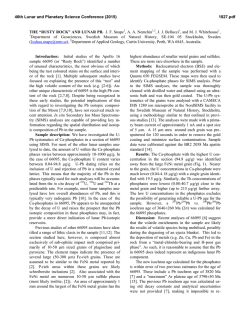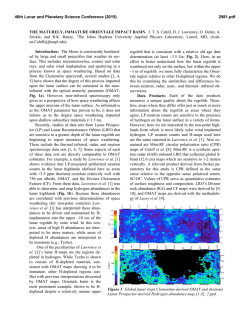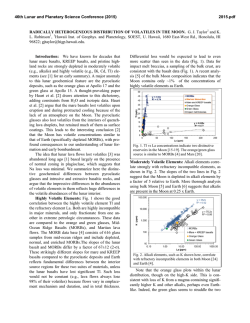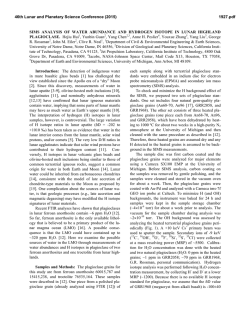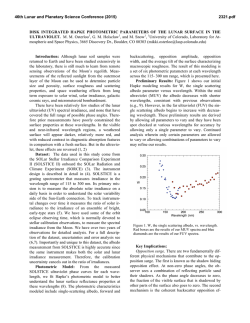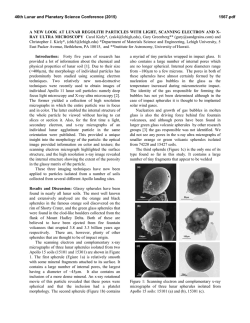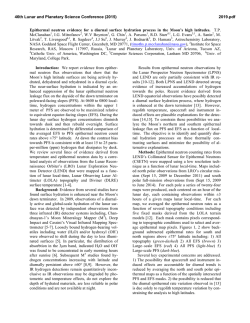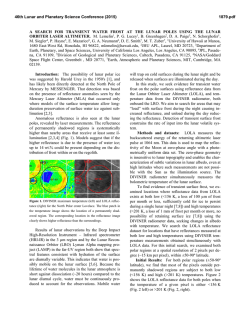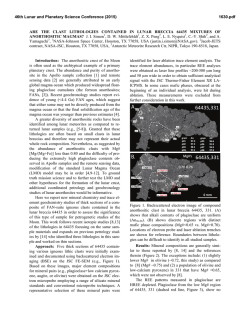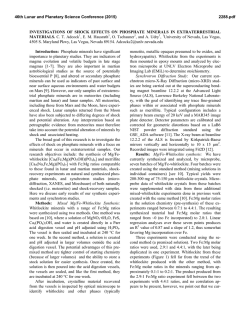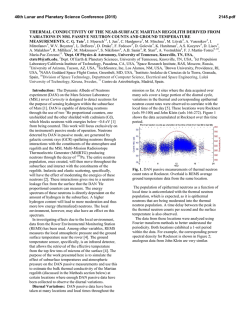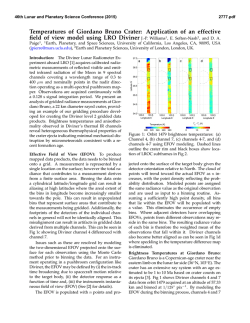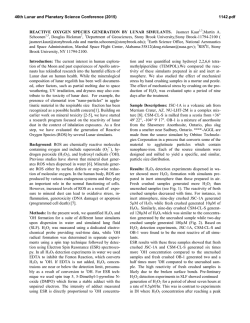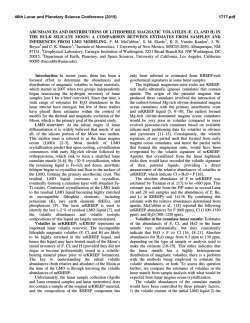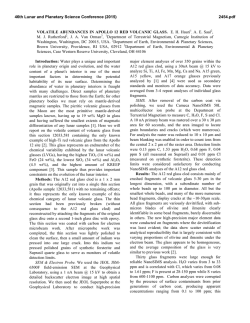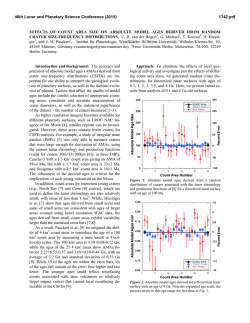
Resolving the Spatial and Depth Dependent Hydrogen Distribution
46th Lunar and Planetary Science Conference (2015) 2235.pdf Resolving the Spatial and Depth Dependent Hydrogen Distribution within Lunar Permanently Shaded Regions Using the Lunar Polar Low-Altitude Neutron Experiment. David J. Lawrence1, Richard C. Elphic2, Richard S. Miller3, Patrick N. Peplowski1, 1Johns Hopkins University Applied Physics Laboratory, Laurel, MD, USA ([email protected]); 2NASA Ames Research Center, Moffett Field, CA; 3University of Alabama in Huntsville, Huntsville, AL, USA. Introduction: Lunar permanently shaded regions (PSRs) are fascinating environments. Their low temperatures (<100K), which have persisted for geologically long periods of time, permit trapping and sequestration of solar system volatiles. Predictions dating back to the 1960s and 1970s proposed that lunar PSRs would have enhanced water concentrations [1,2]. Subsequent spacecraft and Earth-based measurements using various techniques have provided evidence to support these predictions [e.g., 3,4,5]. However, the volatile content of lunar PSRs is substantially less than what is seen within similar environments on Mercury [6,7]. The reason for this difference is not understood. The characteristics of PSRs and the processes that take place in them have implications for a variety of topics such as the origin and history of solar system volatiles [8], synthesis of organic materials [9], and in-situ resources for human exploration. Despite the fact that initial measurements of lunar PSRs have been made, many aspects of PSRs are not well understood. In particular, our knowledge of the spatial distribution and depth dependence of hydrogen concentrations at the lunar poles is tantalizingly incomplete. Here, we update a previous study [10] by futher characterizing the extent to which a lowresource orbital mission can achieve significant improvements in our knowledge of the lunar polar hydrogen distribution. Improved knowledge of the polar hydrogen spatial and depth distribution will provide key input to studies of PSR volatile processes by isolating individual craters that may host enhanced hydrogen and can enable discrimination of various hypotheses that explain the formation and geologic history of the polar volatiles [11]. Data from such a mission will assist future landed missions that seek to target landing sites with volatile enhancements [12]. Hydrogen Measurements of Planetary Surfaces: Polar hydrogen enhancements were first measured on the Moon using the Lunar Prospector Neutron Spectrometer (LP-NS)[3]. The LP-NS was an omnidirectional detector whose spatial resolution was proportional to its orbital altitude (~30 km), and as a consequence its spatial resolution was sufficiently broad that individual hydrogen enhancements were generally not tied to specific PSRs. Nevertheless, combined measurements of epithermal and fast neutrons have been used to show that bulk hydrogen enhancements in Shackleton crater at the Moon’s south pole reach to the surface [13], in contrast to other polar regions where the hydrogen enhancements are likely buried by tens of cm of dry soil [14]. To obtain higher spatial resolution measurements, the Lunar Reconnaissance Orbiter (LRO) spacecraft carried a collimated neutron detector known as the Lunar Exploration Neutron Detector (LEND)[15], which was planned to quantify hydrogen concentrations at a spatial resolution of 10 km near both lunar poles. In light of the difficulties associated with improving orbital neutron measurements with neutron collimation [16–20], we have investigated the benefits of conducting a mission whose altitude over one of the poles is significantly lower than that of the LP-NS measurements. In this scenario, omnidirectional neutron measurements can provide improved the spatial resolution proportional to the ratio of the respective altitudes. Lunar PLANE Mission: The Lunar Polar LowAltitude Neutron Experiment (PLANE) can be accomplished with simple neutron sensor on a small spacecraft and would make high spatial resolution measurements of the Moon’s south pole. Spatially resolved bulk hydrogen concentrations are measured using epithermal neutrons; spatially-resolved depth-dependent hydrogen concentrations are obtained with fast neutrons. A borated plastic scintillator makes measurements of both epithermal and fast neutrons [21]. The nominal mission scenario provides for lowaltitude (<20 km) passes over the lunar south pole with higher-altitude apoapsis (~200 km) values over the north pole to provide orbital stability. The spatial resolution performance of the Lunar PLANE mission is driven by two primary factors: 1) altitude dependent spatial footrprint; and 2) accumulation-time dependent statistical sensitivity. To assess the statistical sensitivity, we use the likelihood ratio method that was designed for analysis of LP and LRO neutron data [19]. This method combines the expected accumulation time with point-to-point statistical uncertainties over a given spatial pixel size. Fig. 1A shows a polar map of relative epithermal neutron signal magnitudes that would be measurable on 15 km sized pixels with a statistical significance threshold of three sigma. A 30 ppm hydrogen sensitivity contour is shown, which illustrates that highly sensitive hydrogen concentration measurements would be obtained poleward of 82ºS. Similar sensitivities for fast neutrons on pixel sizes of 30 km 46th Lunar and Planetary Science Conference (2015) are shown in Fig. 1B. The red contour line shows a hydrogen sensitivity contour of 200 ppm. Because epithermal and fast neutrons probe hydrogen deposits to different depths, a combined analysis enables spatially resolved stratigraphy determination and/or depth constraints to be placed on identified hydrogen enhancements [7,12]. We estimate that hydrogen concentrations of 200 ppm could be detected and quantified under a dry covering to depths of 25 cm with a spatial resolution of 30 km. The combined effects of spatial footprint and statistical precision are assessed using a simulated neutron count rate map where we used the spatiallyreconstructed neutron count rate map of [20] as an assumed ground truth. To simulate the neutron measurements for the Lunar PLANE mission scenario, we use neutron transport simulations that have been validated for prior planetary missions [7]. Fig. 2A shows the simulated count rate map and Fig. 2B shows the measured map derived from LP-NS data. All of the largest PSRs are spatially resolved, which is in contrast to the measured LP-NS data that show a much broader spatial resolution. Conclusions: The Lunar PLANE mission concept provides a high-heritage, low-risk means to significantly improve our knowledge of the spatial and depth dependent hydrogen distribution at the Moon’s south 2235.pdf pole. With the performance presented here, we would unambiguously identify the hydrogen concentrations both inside and outside PSRs as well as provide spatially resolved hydrogen depth measurements over large portions of the lunar south pole. References: [1] Watson, K. et al. (1961) JGR 66, 3033; [2] Arnold, J. R. (1979) JGR 84, 5659; [3] Feldman, W. C. et al. (1998) Science, 281, 1496; [4] Colaprete, A. et al. (2010) Science, 330, 463; [5] Spudis, P. D. et al. (2010) GRL, 37, 10.1029/ 2009GL042259; [6] Harmon et al. (2011) Icarus, 211, 37; [7] Lawrence, D. J. et al. (2013) Science, 339, 292; [8] Lucey, P. G. et al. (2009) Elements, 5, 41; [9] Crites, S. T. et al. (2013) Icarus, 226, 1192; [10] Lawrence, D. J. et al. (2014) Ann. Meeting LEAG, Abstract #3042; [11] Siegler, M.A. et al. (2015) 46th LPSC; [12] Carpenter, J. D. et al. (2012) Pl. Sp. Sci., 74, 208; [13] Miller, R. et al. (2014), Icarus, 233, 229; [14] Lawrence, D. J., et al. (2006), JGR, 111, 10.1029/ 2005JE002637; [15] Mitrofanov, I. G. et al. (2010) Sp. Sci. Rev., 10.1007/s/11214-009-9608-4; [16] Lawrence, D.J. et al. (2010) Astrobio., 10, 183; [17] Lawrence, D.J. et al. (2011) Science, 334, 1058; [18] Eke, V.R. (2012) Ap. J., 747, 6; [19] Miller, R.S. et al. (2012) JGR, 117, 10.1029/2012JE004112; [20] Teodoro, L.F.A. et al. (2014) JGR, 10.1002/2013JE004421; [21] Goldsten, J. O. et al. (2007), Sp. Sci. Rev., 10.1007/s11214-007-9262-7. A Hayworth A Shoemaker Faustini Cabeus B Hayworth B Shoemaker Faustini Cabeus Fig. 1. Contours of statistically significant neutron signal reductions poleward of 80ºS using the Lunar PLANE accumulation times for a six month mission. A) Epithermal neutron signal reductions for 15 km sized pixels. All measurements inside the red contour indicates a hydrogen sensitivities better than 30 ppm. B) Fast neutron signal sensitivities for 30 km sized pixels. All measurements inside the red contour indicates a hydrogen sensitivities better than 200 ppm. Fig. 2. Epithermal neutron count rate maps poleward of 80ºS. A) Simulated map of Lunar PLANE count rates where the assumed distribution is based on [20]. B) Measured LP-NS data.
© Copyright 2025
